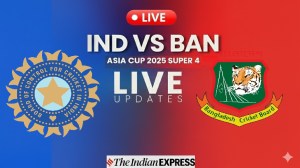 Voters in queue at Hariyabara polling booth in Araria on Thursday, Nov 05,2015. (Express Photo By prashant Ravi)
Voters in queue at Hariyabara polling booth in Araria on Thursday, Nov 05,2015. (Express Photo By prashant Ravi)
Ladli Khatoon, 18, woke up early to ensure she was first in the queue of women voters at Gulabbagh in Purnea. “Apne man se vote dalungi,” said the delighted class 12 student, her face veiled. Behind her stood a number of Muslim women of various ages, their eagerness obvious, and matched by that of the men in the other queue at the booth where over 2,400 voters are registered.
It was an enthusiasm seen across Purnea district, where the turnout rose to 63 per cent from the 60 per cent of 2010. Across phases, voting in Bihar closed at 56.80 per cent Thursday, the highest in the state’s assembly election history, the Election Commission said. It was 53 per cent in 2010.

The fifth and final phase saw a turnout of just under 60 per cent, five points above the 55 per cent of 2010. And women once against outnumbered men, 64 per cent to 56.
[related-post]
Story continues below this ad
Gulabbagh is part of Purnea Sadar, stage of a straight fight between the BJP’s Vijay Kumar Khemka and the Congress’s Indu Sinha. As a frail and elderly Muslim woman walked with an urgency towards the booth, her voter I-card tucked in the folds of her saree, Amit Kumar Sah, a shopkeeper, looked at her and said, “There is no need to guess whom they are voting for.”
From Purnea’s Gulabbagh to several booths in Araria district, Muslims voted aggressively and many declared without hesitation that their choice was the grand alliance candidate in their seat. Some chanted the now well-known election slogan Phir ek bar Nitish Kumar without prompting.
 Others said Nitish “needs five more years to keep his good work going”. A voter at Hariabada in Araria joked, “There is such a long queue; voters are so enthusiastic. Nitish Kumar should have made arrangements for breakfast.”
Others said Nitish “needs five more years to keep his good work going”. A voter at Hariabada in Araria joked, “There is such a long queue; voters are so enthusiastic. Nitish Kumar should have made arrangements for breakfast.”
Some elderly voters in Araria, which has a Muslim population over 43 per cent, were wary of “counter-polarisation”, noting that “Hindu bhais too look united”.
Story continues below this ad
At Lakhanjhari, villagers said the Nitish government has given roads to every mohalla and improved power supply. When some complained of power cuts during study hours, others shot back: “How much power do you want? Nitishji has other things to take care of.” The contest here is between Abdur Rahman of the Congress and Ajay Jha of the LJP. The village has about 2,400 voters, 90 per cent of them Muslims.
At MS Hariawada School, there was no separate queue for the elderly, and some of them decided to sit on the ground after marking their positions in the queue. So did some of the younger women.
“I earn Rs 500 a day,” said Mohd Ibrar, “but we should spare one day for the sake of democracy.” Mohammed Israel, who works at a hotel and earns Rs 250 a day, called himself a keen follower of politics. He predicted Nitish is a sure winner.
At the polling booth at Madarsa Islamia Hashmia in Forbesganj, the elderly Hatim Khan was taking updates on the turnout. “The area has Mandals and Mushahars besides Muslims. We sense a hint of polarisation of Hindu voters as well. The local BJP MLA enjoys a good reputation and will cut into some Muslim votes,” said Khan, adding EBC and Dalit votes are divided.
Story continues below this ad
Gulab Khan, who is in his early thirties and works in Saudi Arabia as a driver, said some Muslim youths had pressed the NOTA button. “Such people should go to Pakistan,” he said angrily. “They should have helped take Nitish to the top.”
At Nathpur in Narpatganj, Rahul Kumar Chauhan, who runs a roadside eatery, said he missed out on voting this year as he is only 17. “This is an EBC Nonia belt,” he said. “The lotus is blooming here.”

 Voters in queue at Hariyabara polling booth in Araria on Thursday, Nov 05,2015. (Express Photo By prashant Ravi)
Voters in queue at Hariyabara polling booth in Araria on Thursday, Nov 05,2015. (Express Photo By prashant Ravi)































